Silky-smooth Nama Chocolate with fresh cream simply melts in your mouth. Rich, moist, and decadent, these sweets are a very popular gift item from Japan. With my copycat recipe of the famous ROYCE‘ chocolate, you can easily make this special treat at home.
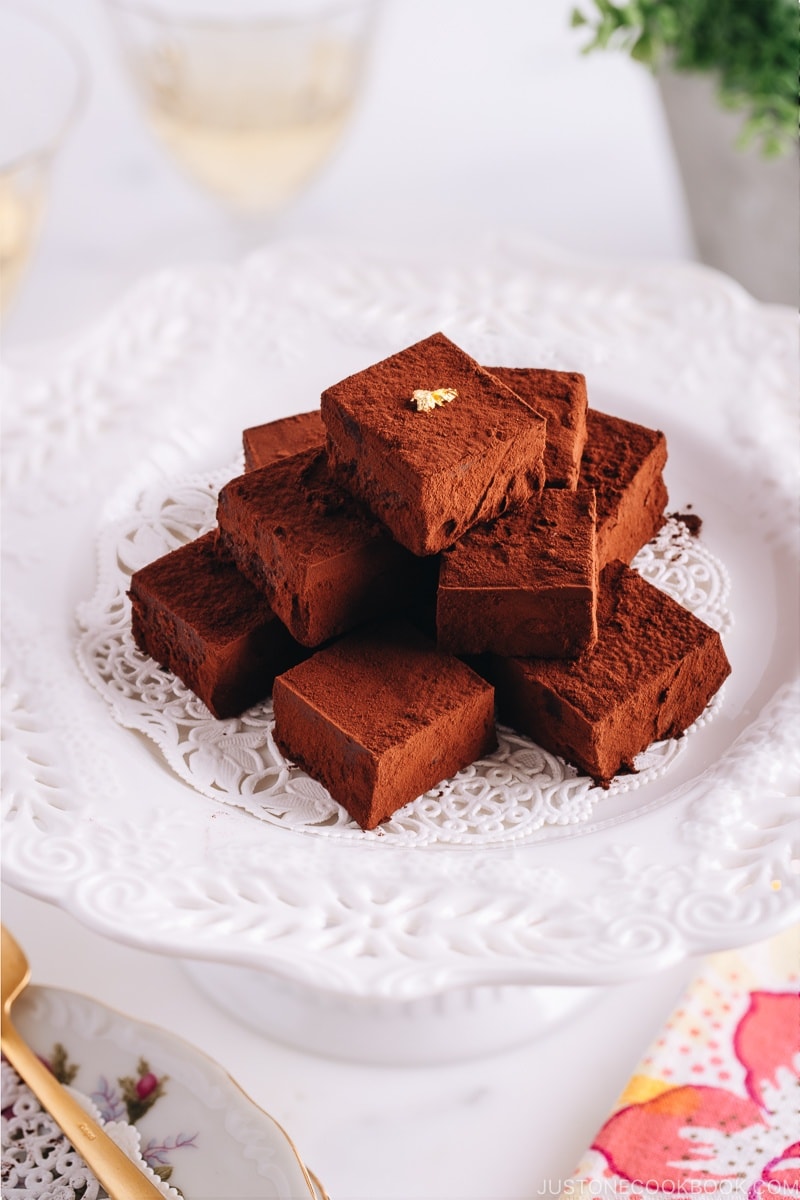
If you are a frequent visitor to Japan, you probably have heard of or tasted this Japanese chocolate called Nama Chocolate (生チョコレート). You can’t really avoid it at the airport gift shops. They come in fancy packaging that makes them a popular gift item to bring home from Japan.
Nama Chocolate is rich, smooth, and moist, with a silky texture that practically melts in your mouth. The good news is you don’t have to fly to Japan to enjoy the luxurious sweet. With this recipe, you can make your chocolate dream come true today!

Table of Contents

What is Nama Chocolate?
Nama Chocolate is a form of chocolate ganache, similar to the filling inside French truffles. It’s made of fresh cream and chocolate, cut into little cubes, and dusted with fine cocoa powder.
We can only call it “Nama Chocolate” when it contains at least 40% chocolate and 10% cream by weight, and no more than 10% water.
Nama Chocolate is much easier to prepare than chocolate truffles because the chocolate mixture is poured into a square pan, chilled until firm, then cut into mini squares. No messy hands since there’s no rolling required, but it has the same decadent chocolate flavor.

What Does Nama Mean?
Nama (生, pronounce [na-ma]) means raw or fresh in Japanese. The name Nama Chocolate refers to the plentiful use of rich, fresh cream in the chocolate.
Because of the fresh cream, we must refrigerate Nama Chocolate at all times and enjoy them within 4 days of making them. You can also keep in the freezer for up to a month.
If you’re planning to give Nama Chocolate as a gift, make sure to let the gift receiver know to consume soon.
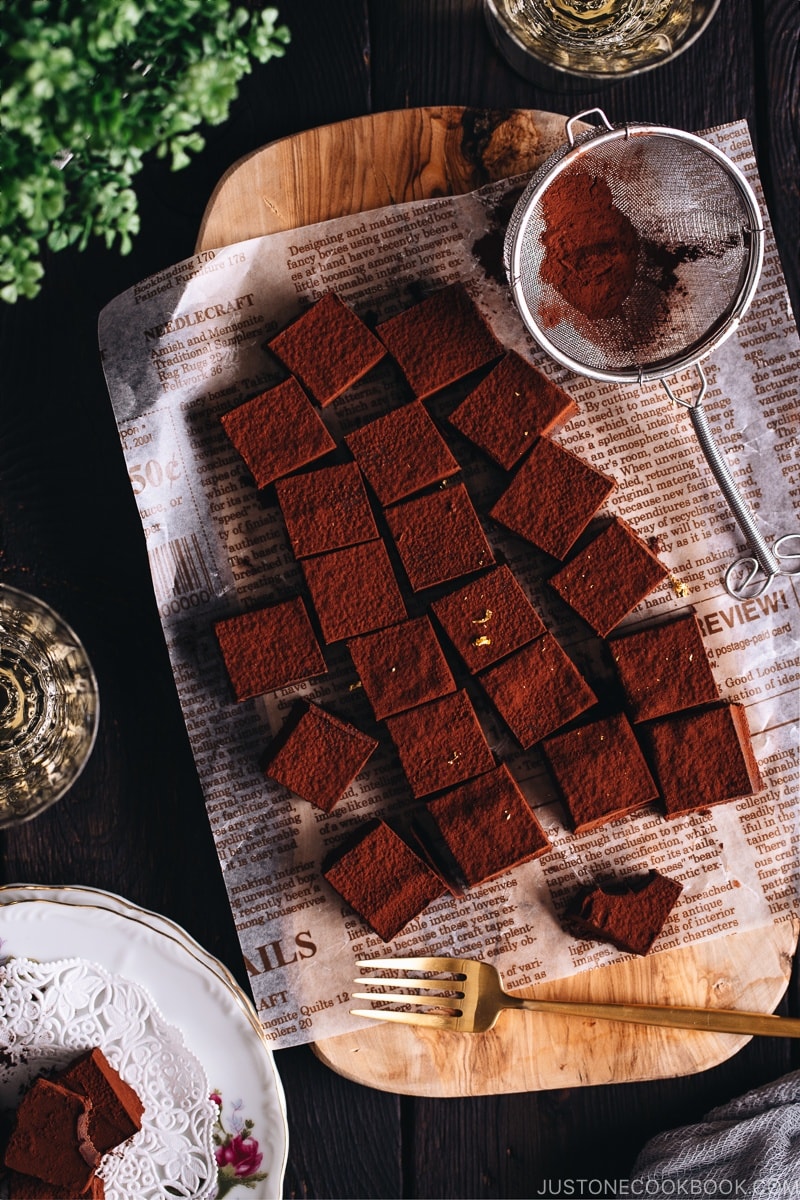
History of Nama Chocolate
In 1988, the owner and chef Masakazu Kobayashi at the sweet shop Sils Maria created a new type of chocolate, and he named this chocolate Nama Chocolate and Nama Choco (生チョコ) for short.
In 1993, Meiji, a snack company, released a chocolate product called Meltykiss (メルティーキッス) which was produced and supervised by chef Kobayashi. You can purchase a box of Meltykiss at Asian supermarkets, convenience stores, and train kiosks in Japan. This chocolate is known for its limited-time offering during the winter months as the chocolate melts quickly during the rest of the seasons.

Since then, major confectionery manufacturers started to sell Nama Chocolate, and it became a huge trend all over the country.
In 1996, Hokkaido-based ROYCE’ (ロイズ) released ROYCE’ Nama Chocolate. Many of you probably spotted this chocolate at the airports or gift shops at sightseeing spots in Japan. Due to their popularity, this Nama Chocolate is known to visitors who have been to Japan.

Although “Nama Chocolate” was invented in Japan in the late ’80s, this specific type of chocolate called “Pave de Geneva” was born in Geneva, Switzerland in 1930s. Pave de Geneva is made of chocolate and fresh cream and cut into small cubes smeared with cocoa, just like Nama Chocolate.
I’m not sure whether the Japanese chef had traveled to Geneva and knew of Pave de Geneva, or he figured out the Nama Chocolate formula on his own. Regardless, this is not an original Japanese product as it existed in Switzerland.
If you’re a Genevan who tried both Pave de Geneva and Nama Chocolate, please share your thoughts in the comments below. Are they similar or exactly the same?
Ingredients You’ll Need
You only need three ingredients (and four with the optional liqueur) for this ROYCE’ copycat recipe.
- dark chocolate (70% cacao) – choose a good-quality product; use semisweet chocolate if you prefer a less bitter taste
- heavy (whipping) cream – use cream with 36% milkfat
- liqueur of your choice – optional, to taste; I use brandy
- Dutch-process cocoa powder – to dust on the chocolate squares; you can buy it on Amazon

How to Make Nama Chocolate
Here’s a brief overview of how to make this sweet treat; see the recipe card below for the complete instructions.
- Chop the dark chocolate bar (or block of chocolate) into smaller pieces with a sharp knife.
- Line a square baking dish with parchment paper.
- Heat the cream in a small saucepan over medium heat on the stove. Do not boil. When you see small bubbles form around the edges of the saucepan, remove it from the heat.
- Add the chocolate pieces into the cream and stir with a silicone spatula to combine. Mix until the chocolate is melted and there are no more lumps. Add the optional liqueur and stir.
- Pour the smooth chocolate mixture into the prepared baking dish. Chill in the fridge for several hours until firm.
- Cut into squares with a sharp knife run under warm or hot water and wiped dry with a kitchen towel. Dust with cocoa powder.
Keep the Nama Chocolate refrigerated until ready to serve. Let it sit at room temperature for 5–10 minutes beforehand so it‘s soft enough to melt in your mouth.
The prep time plus cook time is 30 minutes, but with 4 hours of chilling time, the total time for this recipe is 4.5 hours.
Tips for Making Nama Chocolate
1. Use Good Chocolate
High-quality chocolate is mandatory since that’s the most important ingredient for making delicious Nama Chocolate. Make sure the chocolate is made of 100% cocoa butter and does not include vegetable fat in the ingredient list.
2. Use Heavy Cream
American heavy cream or heavy whipping cream (they are the same thing) has a 36–38% fat content. The ratio of heavy (whipping) cream (gram/ml) and chocolate (gram) should be 1:2.
3. Dry and Clean Utensils
Make sure the bowls and utensils you are using are perfectly dry. Even a small amount of water/steam can “seize” the chocolate melting process. It can happen all of the sudden from a smooth bowl of liquid chocolate to a lumpy, grainy mass of chocolate.
4. Do Not Substitute White Chocolate
For this recipe, please do not replace chocolate with white chocolate. For a white chocolate version, you can make my matcha Green Tea Nama Chocolate recipe, which includes unsalted butter as an additional ingredient.

FAQs
Why did my chocolate release oil?
Separation (when oil comes out of the chocolate) happens when you get the chocolate too hot. Never heat dark chocolate above 120ºF (49ºC) and never heat milk chocolate and white chocolate above 110ºF (43ºC). When chocolate gets too hot, the cocoa butter separates from the solids, and there is no way to salvage it (although you can bake with it and it tastes fine).
The best way to prevent separation is to stir the mixture frequently. Since we’re not using a double boiler in this recipe, make sure you do not bring the mixture to a full boil. Remove from the heat as soon as you see bubbles around the edges of the saucepan.
Why did my chocolate seize?
Seizing happens when moisture is introduced to melted chocolate, even a tiny amount of liquid or steam. When this happens, a smooth bowl of liquid chocolate can suddenly become a lumpy, grainy mass. To prevent this, make sure the bowls and utensils that you are using are perfectly dry.
Can I use white chocolate in this recipe?
Please do not replace the chocolate with white chocolate for this recipe. The ratio of heavy cream to chocolate is not the same as this recipe. If you want to make a white chocolate version, see my Matcha Chocolate recipe.
Other Chocolate Recipes You’ll Love
These chocolate goodies and desserts are perfect for special occasions or as a hostess gift during the holiday season. I hope you enjoy making this Nama Chocolate recipe!
- Chocolate Gateau (Chocolate Cake)
- Frozen Chocolate Banana
- Chocolate Covered Strawberries
- Chocolate Almond Toffee
- Chocolate Chiffon Cake
- Matcha Gateau au Chocolat
- Chocolate Chip Cookies with Nutella
- Valentine’s Day Chocolate Recipes

Wish to learn more about Japanese cooking? Sign up for our free newsletter to receive cooking tips & recipe updates! And stay in touch with me on Facebook, Pinterest, YouTube, and Instagram.
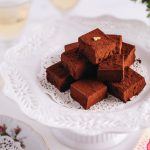
Nama Chocolate
Video
Ingredients
- 14 oz good-quality dark chocolate (70% cacao) (use semisweet chocolate if you prefer a less bitter taste)
- 200 ml heavy (whipping) cream (¾ cup + 4 tsp; 36% milkfat)
- 1 Tbsp liqueur of your choice (optional, to taste; I use brandy)
- Dutch-process cocoa powder (to coat the chocolate; you can buy it on Amazon)
Instructions
Before You Start…
- Please note that this recipe requires a chilling time of 4 hours. Also, read the Notes section at the end of this recipe card for important tips to successfully make this Nama Chocolate.
- Gather all the ingredients.

To Prepare the Nama Chocolate
- With a sharp knife, chop 14 oz good-quality dark chocolate (70% cacao) into smaller pieces so that they will melt faster and more evenly.

- Line an 8- x 8-inch (20- x 20-cm) baking dish with parchment paper. Tip: To make the chocolate the correct height, it‘s important to choose a dish or tray that‘s the right size; if you use a bigger tray, the chocolate will be flatter.

- Add 200 ml heavy (whipping) cream (¾ cup + 4 tsp) into a small saucepan over medium heat. Heat the cream to ALMOST a boil. Whisk lightly to evenly distribute the heat. Keep an eye on the cream to make sure it doesn‘t boil. Tip: Overheating the cream may cause the chocolate to separate in the next step (see Notes below for more information).

- When you see small bubbles form around the edges of the saucepan, remove it from the heat.

- Next, add the chocolate pieces into the cream and stir with a silicone spatula to combine. Tip: Make sure your utensil is completely dry; introducing even a tiny amount of water or steam may cause the melted chocolate to seize (see Notes below for more details).

- Mix until the chocolate is melted and there are no more lumps. The chocolate and cream mixture should be completely smooth.

- If you‘d like, add 1 Tbsp liqueur of your choice (optional), and stir to incorporate.

- Pour the mixture into the prepared baking dish and smooth the surface with the silicone spatula.

- Tap the baking dish onto the counter a few times to make sure the chocolate is evenly distributed. Refrigerate until firm, about 4–5 hours.

To Cut the Chocolate
- After chilling for 4–5 hours, remove the chocolate with its parchment paper from the baking dish. Peel away the parchment paper from the sides.
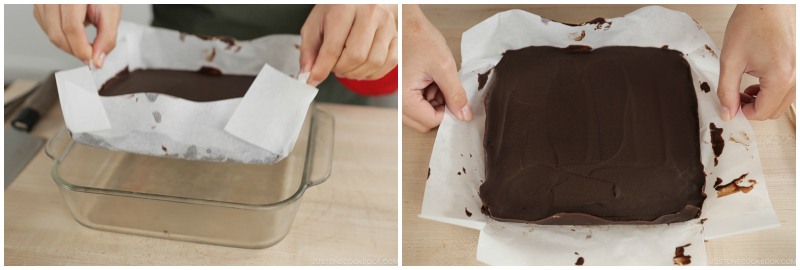
- With a sharp knife, cut off the stray pieces of excess chocolate around the four sides to make sharp corners and edges.

- Warm up the knife with a hot towel. Then, cut the chocolate slab into 1-inch (2.5-cm) strips. Make sure to clean and warm the knife before each cut to achieve a nice sharp cut.

- If your baking dish has curved edges and corners like mine, the edge strips may not be the ideal shape for cutting into neat chocolate cubes. If that‘s the case, cut off and save these chocolate pieces for yourself to enjoy.
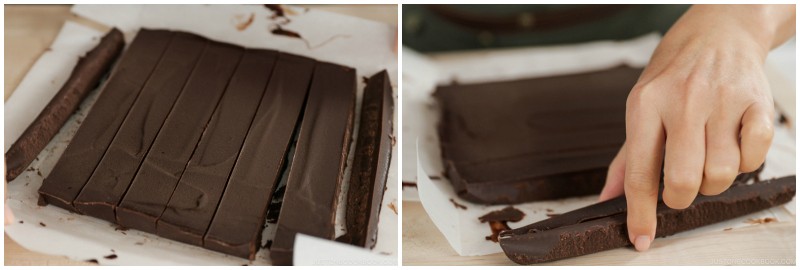
- Next, cut the strips into cubes. Remember to clean and warm up the knife before each cut.

- Using a sugar duster or fine-mesh sieve, sprinkle the cubes on top with Dutch-process cocoa powder. Optionally, if you prefer the powder to completely cover the chocolate, you can dip each piece in the cocoa powder to coat all sides.
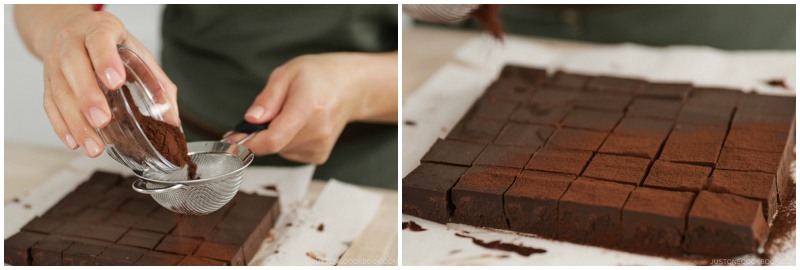
To Serve
- Keep the Nama Chocolate refrigerated. Serve it on a plate, or put it in a box as a gift. I recommend letting the chilled and firm chocolate sit at room temperature for 5–10 minutes before serving so it‘s soft enough to melt in your mouth.

To Store
- Keep in an airtight container and store in the refrigerator for up to 4 days or in the freezer for up to a month.
Notes
- Separation (when oil comes out of the chocolate) happens when you get the chocolate too hot. Never heat dark chocolate above 120ºF (49ºC) and never heat milk chocolate and white chocolate above 110ºF (43ºC). When chocolate gets too hot, the cocoa butter separates from the solids, and there is no way to salvage it (although you can bake with it and it tastes fine). The best way to prevent separation is to stir the mixture frequently. Since we’re not using a double boiler in this recipe, make sure you do not bring the mixture to a full boil. Remove from the heat as soon as you see bubbles around the edges of the saucepan.
- Seizing happens when moisture is introduced to melted chocolate, even a tiny amount of liquid or steam. When this happens, a smooth bowl of liquid chocolate can suddenly become a lumpy, grainy mass. To prevent this, make sure the bowls and utensils that you are using are perfectly dry.
- To learn more details and how to fix overheated or seized chocolate, please read here.
- The ratio of heavy whipping cream and chocolate should be 1:2. Please do not replace the chocolate with white chocolate for this recipe. The ratio is not the same.
Nutrition
Editor’s Note: The post was originally published on February 6, 2012. The content has been updated.









thanks so much for this recipe. i want to try these. royce just came to nyc and i’m addicted. i’d love to make my own.
Thank you Dina! Oh so lucky! Hope SF will get ROYCE’ soon too! Enjoy! 🙂
Hi Nami. Westfield San Jose has Royce too.
Hi JK,
Yes! Thank you for the update.😉
I had an attempt at this…I followed the recipe as far as I could…but I didn’t get too far…I used very high quality cooking chocolate 70% cocoa…and the right cream..however in the end when I used all 400g of the chocolate, the end product became super oily and lumpy, what happened? :/
Hi Ceres93! I’m sorry it didn’t work out. I think I know the reason because I’ve done it before. I think some of your utensil or pot might have been wet, even small amount of water could cause this. I attach a link here just in case you are interested.
http://candy.about.com/od/workingwithchocolate/a/chocmistakes.htm
Hi Nami, with my pots and utensils I made sure they weren’t wet because I knew it would seize if there was any water in it…is 400g of chocolate too much maybe..?
Thank you for your response Ceres93! I always like my cream to chocolate ratio to be 1:2 for rich flavor and it works for me.
My blogger friend just made Nama Chocolate using my recipe but she increased the cream and added butter and honey.
http://www.notquitenigella.com/2013/02/14/nama-chocolate/
Hope you can adapt and make Nama Chocolate because it’s soooo good… 🙂
Thank you for your friend’s recipe! I’ll have a go at using hers…hopefully I won’t fail this time! |:
Good luck! 🙂
Hello Nami,
I really want to try this recipe of yours as a gift for my boyfriend on Valentine’s. I want to ask if I have to use the type of chocolate that is specially made for cooking, or just any chocolate brand will do (the normal chocolate bars in supermarkets like Lindt or Cadbury). Thank you ^^
Hi Anh! No, you don’t have to but I recommend you to use good quality chocolate. Your choices look good – pick the best one you can find at the supermarket! 😉 Hope you enjoy this recipe. 🙂
Hey Nami! this recipe looks wonderful! & i’m planning to use your recipe to make it for Valentine’s Day. However, i was wondering if I could use silicon molds (http://image.made-in-china.com/2f0j00DvjaLPYWnFqO/Silicone-Chocolate-Mould-Candy-Mold.jpg) instead of an 8″ square baking tin? I happen to live in Singapore, and I’m afraid it would melt by the time I reach school. Is there any other solution other than using a cool pack to keep them not melted? Also, is it possible to use either cocoa butter or powdered sugar to make the chocolate sweeter? So sorry for the many queries!
Hi Christel! Although I’ve never used silicon molds before, I think it’ll work out just fine. 🙂
Well, cool pack or ice or anything to keep it cold is necessary. As long as you can keep it cool ALL THE TIME like refrigerator temperature, it should be fine.
If you could use milk chocolate instead of semisweet if you don’t like the bitter taste of chocolate. I personally prefer more cocoa in it, but milk chocolate will be more mild and you don’t really need to add sugar in it. But of course feel free to adapt to your liking. 🙂 Hope this helps!
thanks so much for your help, Nami!
since that i’m using silicone molds, do i need to grease it before pouring in the mixture?
Hi Christel! I did a little bit research for silicone mold method. It looks like the best way is to apply thick coating of tempered chocolate on the mold first (you need additional chocolate for this). Put the mold in the refrigerator to let it cool. You make nama chocolate until step #4. Then let it cool down before you pour the chocolate into the molds. You only put 80% full. Drop the mold on the kitchen counter to make the surface flat and smooth. Keep in the fridge till the chocolate is firm.
I haven’t tried this method on my own, so this is what I could advise from my online research. I hope it will work out! Good luck!
thanks so much Nami! tempered chocolate is where i have to let the chocolate cool until a certain temperature and add cocoa butter right?
really sorry, i researched on tempered chocolate before, and there were so many ways, i’m unsure of which method to use!
No problem at all! Here’s the link of Chocolate Tempering in case someone else is interested: http://candy.about.com/od/candybasics/ht/temperchoc.htm
Hope this helps. Please feel free to ask me. 🙂 I’ll answer the best I can.
hey nami!
i would like to do a follow up (:
sadly, due to hot climate, the nama chocolate was still too soft even after refrigerating them for almost a day. i put them in a freezer instead for at least 8 hours, and it’s fine!
as the nama chocolate was too soft, i wasn’t able to take it out from the silicon mold nicely, was they would break.
Wow Singapore is really warm this season. I wish to be in such warm weather as it’s been so cold here.
Thank you for your tip on freezing them. Sounds like that’s a necessary step if the chocolate melts so quickly! Must be hard to give chocolate gifts….and I assume stores won’t carry them at room temperature there.
Thank you very much for trying this recipe and giving me feedback though. I now learned about the difficulty of making this chocolate in hot climate and can advise others properly. 🙂
its looks so delicious, can i just shape it into heart instead retangle? I want to make it for valentine’s day
Hi El! Sure, you can do it. How big the heart shape is going to be? Ideally, you should cut into pieces before you give away. Nama Chocolate is rich and it melts after you take it out from fridge. If you can, I recommend you to cut nicely before packaging, so you can pick up a piece to enjoy. Hope this helps. 🙂
Hello Nami. I am doing an article for valentines in a independent illustration zine and found this recipe which is wonderful. Would I have your permission to include this in my article if I make sure you are credited on the page?
Warm Regards,
Deborah Clerkin
Hi Deborah! Thanks for your email – sending you email. 🙂
>w<.. Uhm.. me and my friend saw this recipe and decided this was the recipe we are going to use to make Valentine Chocolates. I was just wondering how long can the chocolates last not in a refrigerator/cooler since Valentine's Day will be on a school day?
Hi Kelsey! Depending on where you live – do you live in a cold place? This chocolate is preferably kept in fridge or in cold place until about 5 minutes before eaten. They should be eaten when they are slightly soft and cool. Some readers who commented above live in Southeast Asia and said it started to melt while cutting. Hope this helps… 🙂
Hi Nami, just saw this post, utterly tempting! I am going to try making it this weekend. Am thinking of adding alcohol, maybe rum or kahlua. If so, how much should i add? Thanks for this lovely recipe 🙂
Hi Esther! I’m terribly sorry for not getting back to you sooner. I assume you already made it this past weekend.
Someone asked the similar question above and I mentioned 2-4 Tbsp. Hope your Nama Chocolate turned out well. 🙂
Hi Nami
I was planning on making this chocolate for valentine’s day but one problem. The chocolate melts very easily and i was wondering whether it would get melted by the time i reached school. I can’t find 70% cocoa, can i use some other chocolate?
Hi Shahreen! You need to use ice packs to keep it cool especially if where you live is warm. And yes, you can use other chocolate. 🙂
I just made it today and it turned out great, I love it, I heard about nama chocolate for awhile but since I live in America, I couldn’t taste the “real” nama chocolate, now I have my own nama at home. Thank to u 🙂
Btw, I really love green tea flavor so I hope that u can give us the recipe for that by any chance 🙂
Thank u so much !!!
Hi Mimi! Thanks for trying this recipe and I’m glad to hear you enjoyed this nama chocolate! I haven’t created a recipe for the green tea version, but the method is pretty much the same: you will need white chocolate, fresh cream, and matcha powder. But be careful to use white chocolate because it’s harder to handle compared to regular chocolate. 🙂
hello, i LOVE Royce nama chocolate but it is kinda pricey in the Philippines so I would really like to try this recipe. I have no knowledge about alcohol so can you recommend good liqueur? and how much should i add? thank you so much.
anyway your site is awesome 🙂
Hi girlie! I also don’t put alcohol but I know people put Grand Marnier or Cointreau. You can start with 2 Tbsp, and add more if you like. Thank you for your compliment!
I made it last week. The taste is very good. Just having a hard time cutting it. The chocolate sticks so well to the knife. Are there remedies for that?
Thanks
Hi Anne! Thanks for trying this recipe! So happy to hear you liked the taste! Did you warm up the sharp knife with a hot towel and clean/warm the knife before each cut? Very important to cut nicely! 🙂
Thank you for the great recipe, it taste exactly how I remember Royce to be. Can’t thank you enough!!
Aww thanks so much, S! I’m really happy to hear you enjoyed it. I need to make your cognac version soon! 🙂
Hi Sia! Thank you for trying this recipe. I’m really happy your little boy even liked this! 😀 Yay!
Hi there! I was just wondering if you could tell me what the fat percentage of the heavy cream is? I can’t find it over here (i guess they just don’t call it heavy cream) but i figure if something has a similar fat content it should be ok?
Thanks!
I just threw away the package this afternoon (arh!), but according to Wiki, the fat content is 36% or more. Hope it helps. 🙂
http://en.wikipedia.org/wiki/Cream
oh what a shame! but thanks! ^_^ I’ll make them this weekend!
Oh, I miss the chocolates from Royce. They never last in this house. What a wonderfully easy recipe. As I’m not much of a baker, I’m so glad your recipe has such simple ingredients. Definitely would like to give this a try as your pics are just too appetizing.
Thank you so much Kit. 🙂 I hope you enjoy making and eating it! 😉